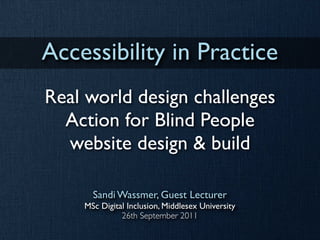Accessibility in Practice
- 1. Accessibility in Practice Real world design challenges Action for Blind People website design & build Sandi Wassmer, Guest Lecturer MSc Digital Inclusion, Middlesex University 26th September 2011
- 2. A website is a product that people interact with Accessibility is not standalone It is one of many design considerations that competes to meet a project's objectives
- 3. If you don't know why, what's the point? Purpose: What's the purpose? Audience: Who's it for? Objectives: What must the Audience do to fulfil the Purpose? Plan: How will they do it?
- 4. The Team Relationships underpin everything. Knowledge, skill and experience are meaningless without respect, understanding & communication.
- 5. Considerations Content Types: ‚Ä£ Text ‚Ä£ Graphics ‚Ä£ Images ‚Ä£ Audio ‚Ä£ Video ‚Ä£ Downloadable Documents
- 6. Considerations Design: ‚Ä£ Conceptual ‚Ä£ Visual ‚Ä£ User Interface ‚Ä£ Information Architecture ‚Ä£ Interaction
- 7. Considerations Client Side Development: ‚Ä£ Content HTML ‚Ä£ Style CSS ‚Ä£ Experience Javascript
- 8. Considerations Server Side Development: ‚Ä£ CMS ‚Ä£ Database ‚Ä£ Programming
- 9. Considerations Best Practices: ‚Ä£ Design ‚Ä£ Development ‚Ä£ Content Strategy ‚Ä£ Web Standards ‚Ä£ User Experience ‚Ä£ Usability ‚Ä£ Accessibility ‚Ä£ User Testing
- 10. User Experts are involved from the start Learning: collating existing knowledge, conducting market research, analysis, reporting Scoping: functional scoping, technical scoping, use cases documentation Prototyping: schematics, user journeys, wireframes, user interactions Testing: features & functionality, task completion, accessibility conformance, markup validation, browser & device compatibility, assistive technologies
- 11. Laying the foundation ‚Ä£ Clean semantic markup ‚Ä£ XHTML 1.0 Strict vs HTML 4.01
- 12. User Interfaces ‚Ä£ Intuitive ‚Ä£ Consistent ‚Ä£ Memorable
- 13. Information Architecture ‚Ä£ Well Structured ‚Ä£ Meaningful ‚Ä£ Consistent ‚Ä£ Informative
- 14. Findability ‚Ä£ Search ‚Ä£ Filter ‚Ä£ Navigation ‚Ä£ Sitemap
- 15. Presentation ‚Ä£ Style Switcher ‚Ä£ Keyboard Focus ‚Ä£ Screenreader Navigation ‚Ä£ Disable CSS ‚Ä£ Printability
- 16. Presentation: Style Switcher
- 17. Presentation: Keyboard Focus
- 18. Presentation: Screenreader Navigation
- 19. Presentation: Disable CSS
- 20. Presentation: Printability
- 21. Interactions ‚Ä£ Instructions ‚Ä£ Error Prevention ‚Ä£ Error Handling ‚Ä£ Success
- 22. WCAG 2.0: Think. Don't Tick. 1.4.4 Resize text: "....text can be resized without assistive technology up to 200 percent" (Level AA) 200 percent of what?
- 23. WCAG 2.0: Think. Don't Tick. 3.1.5 Reading Level: When text requires reading ability more advanced than the lower secondary education level after removal of proper names and titles, supplemental content, or a version that does not require reading ability more advanced than the lower secondary education level, is available. (Level AAA) Sure. Right after I rewrite War and Peace.
- 24. WCAG 2.0: Think. Don't Tick. 2.4.4 Link Purpose (In Context): "The purpose of each link can be determined from the link text alone or from the link text together with its programmatically determined link context, ...." (Level A) Made sense until we tested with screen reader users who group links out of context.
- 25. WCAG 2.0: Think. Don't Tick. 1.1.1 Non-text Content: "All non-text content that is presented to the user has a text alternative that serves the equivalent purpose..." (Level A) Is the purpose to describe or convey meaning?
- 26. Testing, Testing, Testing Experts: test the whole website for conformance against known standards and objectives Users: are set a series of tasks to complete that determine whether a website is fit for purpose
- 27. Any Questions? Transcript of this presentation available for Download 2011 Sandi Wassmer



























